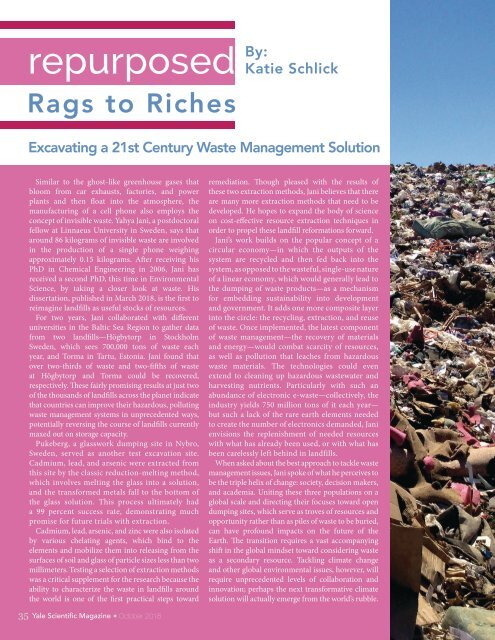YSM Issue 91.3
Create successful ePaper yourself
Turn your PDF publications into a flip-book with our unique Google optimized e-Paper software.
epurposed By:<br />
Katie Schlick<br />
Rags to Riches<br />
Excavating a 21st Century Waste Management Solution<br />
Similar to the ghost-like greenhouse gases that<br />
bloom from car exhausts, factories, and power<br />
plants and then float into the atmosphere, the<br />
manufacturing of a cell phone also employs the<br />
concept of invisible waste. Yahya Jani, a postdoctoral<br />
fellow at Linnaeus University in Sweden, says that<br />
around 86 kilograms of invisible waste are involved<br />
in the production of a single phone weighing<br />
approximately 0.15 kilograms. After receiving his<br />
PhD in Chemical Engineering in 2006, Jani has<br />
received a second PhD, this time in Environmental<br />
Science, by taking a closer look at waste. His<br />
dissertation, published in March 2018, is the first to<br />
reimagine landfills as useful stocks of resources.<br />
For two years, Jani collaborated with different<br />
universities in the Baltic Sea Region to gather data<br />
from two landfills—Högbytorp in Stockholm<br />
Sweden, which sees 700,000 tons of waste each<br />
year, and Torma in Tartu, Estonia. Jani found that<br />
over two-thirds of waste and two-fifths of waste<br />
at Högbytorp and Torma could be recovered,<br />
respectively. These fairly promising results at just two<br />
of the thousands of landfills across the planet indicate<br />
that countries can improve their hazardous, polluting<br />
waste management systems in unprecedented ways,<br />
potentially reversing the course of landfills currently<br />
maxed out on storage capacity.<br />
Pukeberg, a glasswork dumping site in Nybro,<br />
Sweden, served as another test excavation site.<br />
Cadmium, lead, and arsenic were extracted from<br />
this site by the classic reduction-melting method,<br />
which involves melting the glass into a solution,<br />
and the transformed metals fall to the bottom of<br />
the glass solution. This process ultimately had<br />
a 99 percent success rate, demonstrating much<br />
promise for future trials with extraction.<br />
Cadmium, lead, arsenic, and zinc were also isolated<br />
by various chelating agents, which bind to the<br />
elements and mobilize them into releasing from the<br />
surfaces of soil and glass of particle sizes less than two<br />
millimeters. Testing a selection of extraction methods<br />
was a critical supplement for the research because the<br />
ability to characterize the waste in landfills around<br />
the world is one of the first practical steps toward<br />
remediation. Though pleased with the results of<br />
these two extraction methods, Jani believes that there<br />
are many more extraction methods that need to be<br />
developed. He hopes to expand the body of science<br />
on cost-effective resource extraction techniques in<br />
order to propel these landfill reformations forward.<br />
Jani’s work builds on the popular concept of a<br />
circular economy—in which the outputs of the<br />
system are recycled and then fed back into the<br />
system, as opposed to the wasteful, single-use nature<br />
of a linear economy, which would generally lead to<br />
the dumping of waste products—as a mechanism<br />
for embedding sustainability into development<br />
and government. It adds one more composite layer<br />
into the circle: the recycling, extraction, and reuse<br />
of waste. Once implemented, the latest component<br />
of waste management—the recovery of materials<br />
and energy—would combat scarcity of resources,<br />
as well as pollution that leaches from hazardous<br />
waste materials. The technologies could even<br />
extend to cleaning up hazardous wastewater and<br />
harvesting nutrients. Particularly with such an<br />
abundance of electronic e-waste—collectively, the<br />
industry yields 750 million tons of it each year—<br />
but such a lack of the rare earth elements needed<br />
to create the number of electronics demanded, Jani<br />
envisions the replenishment of needed resources<br />
with what has already been used, or with what has<br />
been carelessly left behind in landfills.<br />
When asked about the best approach to tackle waste<br />
management issues, Jani spoke of what he perceives to<br />
be the triple helix of change: society, decision makers,<br />
and academia. Uniting these three populations on a<br />
global scale and directing their focuses toward open<br />
dumping sites, which serve as troves of resources and<br />
opportunity rather than as piles of waste to be buried,<br />
can have profound impacts on the future of the<br />
Earth. The transition requires a vast accompanying<br />
shift in the global mindset toward considering waste<br />
as a secondary resource. Tackling climate change<br />
and other global environmental issues, however, will<br />
require unprecedented levels of collaboration and<br />
innovation; perhaps the next transformative climate<br />
solution will actually emerge from the world’s rubble.<br />
35 Yale Scientific Magazine October 2018


















